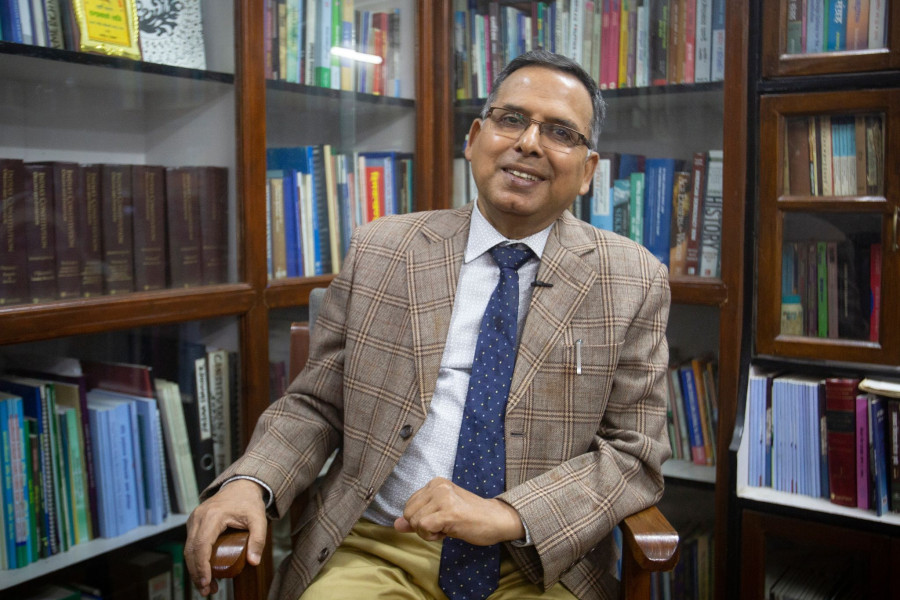Interviews
‘Court verdict doesn’t shield against Parliament dissolution in all cases’
Former dean and professor at the Kathmandu University School of Law and constitutional lawyer Bipin Adhikari on the composition of the lower house and the formation of the new government.
Binod Ghimire
The results of the recently held elections have been announced while parties also have named lawmakers under the proportional representation category. Now, the government formation process will begin after the Election Commission submits its final report to President Bidya Devi Bhandari, possibly within a few days. Binod Ghimire of the Post talked to Bipin Adhikari, former dean and professor at the Kathmandu University School of Law as well as a constitutional lawyer, about the composition of the lower house and the formation of the new government. Excerpts:
Neither the Nepali Congress- nor the CPN-UML-led alliance got a majority. In this case, what is the mandate of the recent elections?
Both the vote share as well as the victories of the parties contesting first-past-the-post elections through poll alliances have gone down. People have not endorsed them fully in the elections. While the strength of the main parties has declined, new forces like the Rastriya Swatantra Party have emerged, which means the major parties must review their working style and correct themselves.
The two parties in the left alliance got an overwhelming majority in the 2017 election and they had the mandate to govern for the next five years. Can we say people voted for a coalition government this time?
Coalition governments are now a compulsion. The larger parties are meant to form the government while the mandate for the smaller parties is to play the role of opposition. With a coalition culture becoming a part of our politics, whichever party (parties) proves a majority gets to lead the government. As the voters haven’t given a majority to a single party, the better choice for now is the formation of a government of the parties that can ensure stability. The goal now should be to build a common front for a stable government.
Do you see any possibility of a stable government?
There is a remote possibility. The CPN (Maoist Centre), the largest revolutionary party in the past, is now a declining force. Among all the options, a Congress-UML government would be the best bet for stability. However, they must form a joint front based on common values and principles.
But wouldn’t it be wrong for the first and the second largest parties to form a government?
First of all, the chances of such a Congress-UML government is slim as the UML during its previous tenure in government openly violated the constitution, for instance, in its decision to dissolve the House. The goodwill the party earned by taking a position against the blockade was eroded by a series of attacks to the constitution. The Congress on the other hand has failed to embrace the conservative democratic values. It has compromised on minimum democratic values by partnering with the Maoist Centre and other parties.
The idea that the first and second forces should not be together in government is gradually losing its relevance. New people with different temperaments have been elected from new parties. They are in politics to challenge established parties. Therefore, the Parliament is now going to be vibrant, unlike in the past. Even if the Congress and UML form a coalition government, there are other parties—the new ones to be precise—to play the role of an effective opposition. The new forces will be wiped out in the next elections if they fail to function and they know it very well.
It will be suicidal for these new forces to join the government as they are yet to take the shape of the parties organisationally. Acting as an effective opposition while also organising the party is what they need to do. I believe they understand this much.
How does the lower House appear in terms of representation?
Article 42 (1) of the constitution says there must be proportional inclusive representation in every state agency. Similarly, there is a clear constitutional provision of 33 percent women representation in the House of Representatives. However, because of the party structures and their nomination process, the inclusive standard hasn’t been implemented. Also, the Election Commission has failed to assert itself in making parties responsible to this effect. As a result, even the constitutional provision on women’s representation is likely to be breached.
The commission, right from the candidate nomination phase, should have asked the parties about their strategies for inclusive representation. Other than announcing election dates, the commission is also responsible for conducting, supervising, directing and controlling elections as well as with the democratisation of the parties. Despite its constitutional authority, the commission is shying away from obliging the parties to adhere to inclusive standards of the constitution, thereby reducing the representation of different communities in the House.
The people, who have won the parliamentary elections multiple times and even become ministers, have been appointed lawmakers under the proportional representation category. The category was introduced with an intent of making the House diverse and ensuring the representation of the communities that have never been to the legislature. But this provision has been grossly misused, as it has come to be employed as a tool of patronage politics.
The commission must publicly explain the reasons for failing to make the parties abide by inclusive principles and, if needed, prepare a bill in line with the constitution. It should take necessary measures in ensuring that party structures are inclusive. Political inclusion is important because if our politics is on the right track other sectors automatically improve.
The Election Commission is preparing to submit final election results to the President, paving the way for a new government. How will the government formation process move ahead?
It is clear that no party commands the strength to form a majority government, and so the next government will be a coalition one. Based on the election results, the President will have to call a meeting of all the parties asking them to present their claim for the government with the needed strength. If one party—the Congress for instance—stakes its claim saying it has support of so and so party to prove 138 members in the lower house, the President will appoint the party’s Parliament party leader as the prime minister after consulting the parties that are extending support. The party claiming government leadership must present an objective basis that it has the support of majority lawmakers.
If coalition bids fail, the Congress as the largest party can form the government but to do so, it has to win a vote of confidence within 30 days.
Whichever party leads the government, it must realise that they have been weakened in the elections and voters want them to improve. Developing a sense of stability by improving its functioning is what people want to see. Otherwise another snap poll could be imminent. When the mainstream parties weaken, that often means a weakening of the democratic process as well.
The constitution bars a no-confidence motion in the first two years of the government. Does that shield the government from being toppled for two years?
Definitely not. Any government, except with a clear majority, must get a vote of confidence within 30 days. If such a government is formed but tomorrow a coalition partner withdraws from the government, it must get a new vote of confidence. Its failure to win the trust means the government has fallen in minority, opening the door for a new government. Not just that, rejection of any bill or motion in the House means the government has lost its majority. In such a case the prime minister should resign or prove a vote of confidence.
The provision of no-confidence motion is only to stop the opposition from the game of making and unmaking of government for two years. In parliamentary democracy, the government can fall any time whenever it lacks a majority.
There is a dominant view that the Supreme Court verdict while reinstating the lower house last year envisions a Parliament functioning for a full five years in all cases. Is that a correct reading?
The Supreme Court’s verdict should be viewed in context. The erstwhile KP Sharma Oli government dissolved the lower house when the prospect for the formation of an alternative government was still alive. The court concluded the dissolution was unconstitutional as the House still could have produced an alternative government. The court verdict doesn’t shield against dissolution in all cases. When all alternatives for government formation are exhausted, the House has to be dissolved for a fresh mandate.
Looking at its present composition, do you see the lower house serving out its five-year term?
It all depends on the stability of the new government. The government must be formed with a comfortable majority so that loss of one party or a few lawmakers doesn’t push it into a minority. We need stability both in figure and policy. However, it is a challenging prospect.
Can one become prime minister without taking oath as a lawmaker? The swearing-in of KP Oli as prime minister had come into controversy for a similar reason.
Yes. There is no hurdle to becoming prime minister without taking oath as a lawmaker. One who commands public mandate can be prime minister. The President, a higher authority to the legislature, appoints the prime minister. However, one has to be elected as the parliamentary party leader before becoming the executive head.




 8.12°C Kathmandu
8.12°C Kathmandu










%20(1).jpg&w=300&height=200)

